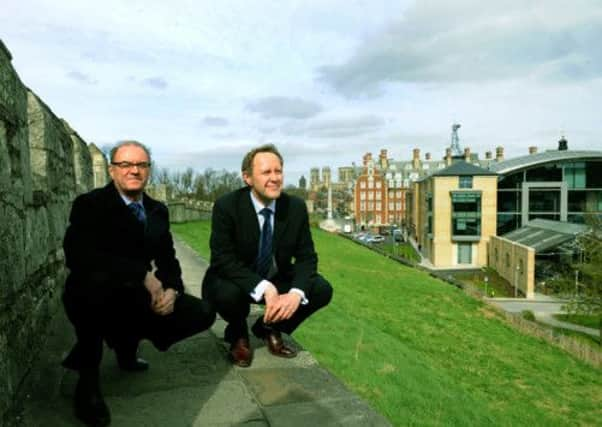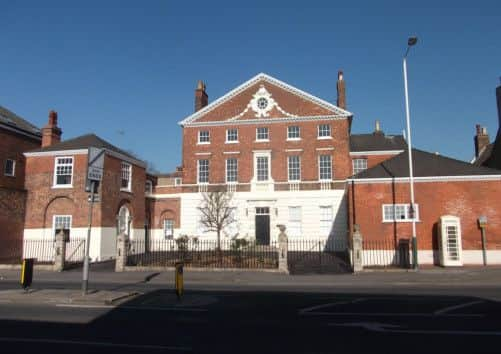Building future growth out of our heritage


WHETHER it’s the sheer size and splendour of the Taj Mahal, or Antoni Gaudi’s remarkable dream-like creations, there’s no doubt that great buildings have the power to astonish.
In Britain we have no shortage of breathtaking towers, halls and palaces either. But while architectural gems are undoubtedly capable of taking our breath away, can they actually be used to boost our economy? English Heritage believes they can saying the redevelopment of historic buildings contributes towards job creation, business growth and economic prosperity.
Advertisement
Hide AdAdvertisement
Hide AdIt has highlighted some of the success stories across the country in a new online publication called Constructive Conservation – Sustainable Growth for Historic Places. A Victorian cutlery works in Sheffield and a Georgian house in Beverley are among the Yorkshire landmarks included in the English Heritage publication which celebrates the use of historic buildings for new businesses.


As well as the Sellers Wheel complex and Norwood House, the three other Yorkshire sites featured are Hellifield Peel Castle, near Skipton, a Victorian era hydro-electric plant in Grassington, North Yorkshire, and the former British Rail offices, in York.
They are among projects up and down the country where English Heritage and local authorities have supported developers in repairing and adapting historic sites to provide a new space for businesses.
In Beverley’s Conservation Area the Grade I listed Norwood House, considered the town’s finest example of a Georgian mansion, was on the Heritage at Risk register and rapidly deteriorating. This grand building, with its striking facade and impressive fireplaces, staircases and library fittings, started to decline when the house, last used as a school, fell out of use in 1998.
Advertisement
Hide AdAdvertisement
Hide AdSubsequent attempts to find a new public use came to nothing so when the Brantingham Group, a local developer with a good track record of sensitively restoring historic buildings, wanted to change the building to offices, English Heritage was keen to offer its support. The conservation body gave advice regarding local concerns about the impact on the setting and the building has now been fully repaired and converted into offices.
The Sellers Wheel in Sheffield is another historic site that has been transformed. This Grade II listed 19th century courtyard complex was originally occupied by the offices, warehouse, workshops and grinding rooms of John Sellers and Sons, which produced some of the world’s best pen and pocket knives, razors and cutlery.
Here, English Heritage worked with the owners, Devonshire Green Holdings, to create a development that generated jobs and at the same time conserved the essence of the site as a reminder of what made Sheffield famous.
Sellers Wheel has now been restored providing two floors of office space as well as a new six-storey residential block used by students at Sheffield Hallam University.
Advertisement
Hide AdAdvertisement
Hide AdOne of the most impressive projects has been the £32m transformation of the former British Rail West Offices in York into the city council’s new headquarters, which opened this year following an 18-month renovation. The original building, which forms part of the new development, was built as a railway station in 1840 before later being turned into railway offices.
However, the shadow of dereliction hung over Grade II* listed building for many years until the recent redevelopment changed its fortunes. Design manager Chris Hale of S Harrison Developments, which led the project in a joint venture with Buccleuch Property, says the building was in urgent need of help.
“For over a hundred years it was a bit of a backwater,” he says. “It was originally designed as a station and being used for offices didn’t work very well and it became a bit of a mish mash.”
For decades it was never fully occupied and developers realised it would need more than just a makeover to make it a viable business site. But when the council was looking for a new HQ the developers came forward with an ambitious plan.
Advertisement
Hide AdAdvertisement
Hide AdEnglish Heritage advised them on how to enhance the building’s railway heritage and Hale says their backing was crucial. “One of the biggest risks for us was planning permission because we were dealing with a Grade II* listed building and we wanted to do significant alterations.
“So knowing that we had the support of English Heritage was essential because it eliminated the risk and it gave us the confidence that we were on the right track,” he says.
Most people probably assume that older historic buildings, like the old railways offices, cost more to run and are less energy efficient than their modern day counterparts.
But Hale says this isn’t always the case and points out that the new building has an energy performance certificate (EPC) rating of ‘B’. You might think this would cost a fortune but the developers used some of the original features, such as the thick Victorian walls, to their advantage. “We didn’t have to spend extra money to help make the building low energy and low carbon we just used its inherent features to our benefit.”
Advertisement
Hide AdAdvertisement
Hide AdThe end result is an impressive building that blends the best of the old and the new. “Our view is that it’s not just about restoring buildings so people can come and see them, it’s about bringing them back into meaningful and effective use.
“You can see more of the building as it used to look like now than at any time since the 1900s and we have proved that old buildings like this former railway station can be just as energy-efficient and just as sustainable as modern buildings.”
The question of finding more places on which to build new homes and businesses is a contentious one but Hale believes we need to make better use of older sites. “It’s far more sustainable to re-use existing sites than build on greenfield sites and out-of-town areas.”
What also makes the West Offices redevelopment so impressive is that it will also save money in the long run. “It’s estimated the council will save a minimum of £17m in energy efficiency and sustainability over the next 25 years, and it’s not often you can say that in this climate,” he says.
Advertisement
Hide AdAdvertisement
Hide AdYorkshire’s planning and conservation director for English Heritage, Trevor Mitchell, believes historic buildings have an important role to play in the prosperity of our towns and cities. “Heritage is sometimes seen as holding back progress when actually the opposite is true because it helps create sustainable places where we can live and work. You see empty buildings and they look like gaps waiting to be filled, but once you start putting people back in them they go from being an eyesore to becoming a landmark.”
Mitchell says redeveloping existing buildings can be easier and cheaper than if you’re starting from scratch. “Historic buildings tend to be in towns or cities where there’s already an infrastructure, it’s not like a new development where you might have to build new roads,
“It’s about making places more sustainable and it’s about showing that old buildings can work as part of a sustainable future. If you take Sellers Wheel in Sheffield, or the old railway offices in York, you see how new buildings can sit alongside old ones to create sustainable developments,” he says.
“The fact we have so many great examples of historic sites that have been put to sustainable and productive use shows to me that heritage is keeping this industry going.”
With Yorkshire very much at the heart of it.
Advertisement
Hide AdAdvertisement
Hide Ad“I’m really proud that we have five buildings in this national document and it shows that Yorkshire is as good as anywhere at making use of its past and putting it to good use.”
To download the English Heritage publication go to www.english-heritage.org.uk/constructiveconservation
English Heritage – the art of constructive conservation
There are 36 historic sites and buildings featured in English Heritage’s new publication – Constructive Conservation – which celebrates the adaptation of historic buildings for new businesses.
This includes five Yorkshire landmarks – the former British Rail offices, in York; the Sellers Wheel complex, in Sheffield; Hellifield Peel Castle, near Skipton; Norwood House, in Beverley, and the Linton Falls Victorian hydropower plant, in Grassington, North Yorkshire.
Advertisement
Hide AdAdvertisement
Hide AdA 2011 study found that investments in listed buildings generated a higher return than investments in commercial property that wasn’t listed.
The same survey revealed that one in four businesses said that the historic environment was an important factor when it comes to deciding where to locate, saying it was equally important as road access.
According to the Heritage Lottery Fund, heritage-related tourism alone accounts for £4.3bn of GDP and is responsible for 113,000 jobs in the UK.
English Heritage manages more than 400 historic sites and monuments.